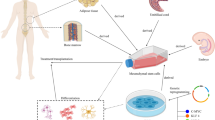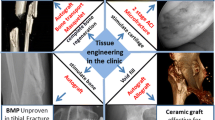Abstract
Purpose
Spine fusion is the gold standard treatment in degenerative and traumatic spine diseases. The bone regenerative medicine needs (i) in vitro functionally active osteoblasts, and/or (ii) the in vivo induction of the tissue. The bone tissue engineering seems to be a very promising approach for the effectiveness of orthopedic surgical procedures, clinical applications are often hampered by the limited availability of bone allograft or substitutes. New biomaterials have been recently developed for the orthopedic applications. The main characteristics of these scaffolds are the ability to induce the bone tissue formation by generating an appropriate environment for (i) the cell growth and (ii) recruiting precursor bone cells for the proliferation and differentiation. A new prototype of biomaterials known as “bioceramics” may own these features. Bioceramics are bone substitutes mainly composed of calcium and phosphate complex salt derivatives.
Methods
In this study, the characteristics bioceramics bone substitutes have been tested with human mesenchymal stem cells obtained from the bone marrow of adult orthopedic patients.
Results
These cellular models can be employed to characterize in vitro the behavior of different biomaterials, which are used as bone void fillers or three-dimensional scaffolds.
Conclusions
Human mesenchymal stem cells in combination with biomaterials seem to be good alternative to the autologous or allogenic bone fusion in spine surgery. The cellular model used in our study is a useful tool for investigating cytocompatibility and biological features of HA-derived scaffolds.



Similar content being viewed by others
References
Minamide A, Kawakami M, Hashizume H, Sakata R, Tamaki T (2001) Evaluation of carriers of bone morphogenetic protein for spinal fusion. Spine 26:933–939
Liao SS, Guan K, Cui FZ, Shi SS, Sun TS (2003) Lumbar spinal fusion with a mineralized collagen matrix and rhBMP-2 in a rabbit model. Spine 28:1954–1960
Cui Q, Ming Xiao Z, Balian G, Wang GJ (2001) Comparison of lumbar spine fusion using mixed and cloned marrow cells. Spine 26:2305–2310
Peterson B, Iglesias R, Zhang J, Wang JC, Lieberman JR (2005) Genetically modified human derived bone marrow cells for posterolateral lumbar spine fusion in athymic rats: beyond conventional autologous bone grafting. Spine 30:283–289
De Long WG, Einhorn TA Jr, Koval K, McKee M, Smith W, Sanders R, Watson T (2007) Bone grafts and bone graft substitutes in orthopaedic trauma surgery. A critical analysis. J Bone Jt Surg Am 89:649–658
Jenis L (2006) Synthetic bone grafts in orthopaedic surgery. US Musculoskeletal Rev 2:48–49
Gazdag AR, Lane JM, Glaser D, Forster RA (1995) Alternatives to autogenous bone graft: efficacy and indications. J Am Acad Orthop Surg 3:1–8
Aaboe M, Pinholt EM, Hjortinghansen E (1995) Healing of experimentally created defects—a review. Br J Oral Maxillofac Surg 33:312–318
Summers BN, Eisenstein SM (1989) Donor site pain from the ilium. A complication of lumbar spine fusion. J Bone Jt Surg Br 71:677–680
Devin JE, Attawia MA, Laurencin CT (1996) Three-dimensional degradable porous polymer-ceramic matrices for use in bone repair. J Biomater Sci Polym Ed 7:661–669
Solchaga LA, Hee CK, Aguiar DJ, Ratliff J, Turner AS, Seim 3rd HB, Hollinger JO, Snel LB, Lynch SE (2011) Augment® bone graft products compare favorably to autologous bone graft in an ovine model of lumbar interbody spine fusion. Spine (Phila Pa 1976). 2011 Oct 21 [Epub ahead of print]
Kang J, An H, Hilibrand A, Yoon ST, Kavanagh E, Boden S (2011) Grafton® & local bone has comparable outcomes to iliac crest bone in instrumented single level lumbar fusions. Spine (Phila Pa 1976). 2011 Nov 8 [Epub ahead of print]
Kerr EJ 3rd, Jawahar A, Wooten T, Kay S, Cavanaugh DA, Nunley PD (2011) The use of osteo-conductive stem-cells allograft in lumbar interbody fusion procedures: an alternative to recombinant human bone morphogenetic protein. J Surg Orthop Adv 20(3):193–197
Huang JW, Lin SS, Chen LH, Liu SJ, Niu CC, Yuan LJ, Wu CC, Chen WJ (2011) The use of fluorescence-labeled mesenchymal stem cells in poly(lactide-co-glycolide)/hydroxyapatite/collagen hybrid graft as a bone substitute for posterolateral spinal fusion. J Trauma 70(6):1495–1502
Yamada T, Yoshii T, Sotome S, Yuasa M, Kato T, Arai Y, Kawabata S, Tomizawa S, Sakaki K, Hirai T, Shinomiya K, Okawa A (2011) hybrid grafting using bone marrow aspirate combined with porous β-tricalcium phosphate and trephine bone for lumbar posterolateral spinal fusion: a prospective, comparative study—versus local bone grafting. Spine (Phila Pa 1976). 2011 Jun 13 [Epub ahead of print]
Buhring HJ, Battula VL, Treml S, Schewe B, Kanz L, Vogel W (2007) Novel markers for the prospective isolation of human MSC. Ann NY Acad Sci 1106:262–271
DiGirolamo GJ, Gilchrist ID, Brown V, Findlay JM (1999) The ability to shift covert attention is not dependent on the experience of moving the eyes: a case study. J Cogn Neurosci:70–71
Weinstein JN, Lurie JD, Tosteson TD, Hanscom B, Tosteson AN, Blood EA, Birkmeyer NJ, Hilibrand AS, Herkowitz H, Cammisa FP, Albert TJ, Emery SE, Lenke LG, Abdu WA, Longley M, Errico TJ, Hu SS (2007) Surgical versus nonsurgical treatment for lumbar degenerative spondylolisthesis. N Engl J Med 356:2257–2270
Baksh D, Song L, Tuan RS (2004) Adult mesenchymal stem cells: characterization, differentiation, and application in cell and gene therapy. J Cell Mol Med 8:301–316
Chou YF, Huang W, Dunn JC, Miller TA, Wu BM (2005) The effect of biomimetic apatite structure on osteoblast viability, proliferation, and gene expression. Biomaterials 26:285–295
Hamilton DW, Brunette DM (2007) The effect of substratum topography on osteoblast adhesion mediated signal transduction and phosphorylation. Biomaterials 28:1806–1819
Acknowledgments
We thank Dr. Carlo Piovani for his technical assistance in performing the bone marrow aspirates during surgery at the Orthopedic Institute “Rizzoli”, Bologna, Italy. This study was supported, in part, by grants from Fondazione Cassa di Risparmio di Bologna, Bologna, Fondazione Cassa di Risparmio di Cento, Cento, Regione Emilia-Romagna and University of Ferrara, Ferrara. Italy.
Conflict of interest
None.
Author information
Authors and Affiliations
Corresponding author
Rights and permissions
About this article
Cite this article
Barbanti Brodano, G., Mazzoni, E., Tognon, M. et al. Human mesenchymal stem cells and biomaterials interaction: a promising synergy to improve spine fusion. Eur Spine J 21 (Suppl 1), 3–9 (2012). https://doi.org/10.1007/s00586-012-2233-z
Received:
Accepted:
Published:
Issue Date:
DOI: https://doi.org/10.1007/s00586-012-2233-z




